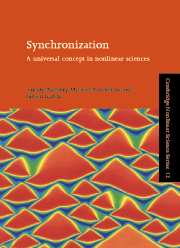Book contents
- Frontmatter
- Contents
- Preface
- Chapter 1 Introduction
- Part I Synchronization without formulae
- Chapter 2 Basic notions: the self-sustained oscillator and its phase
- Chapter 3 Synchronization of a periodic oscillator by external force
- Chapter 4 Synchronization of two and many oscillators
- Chapter 5 Synchronization of chaotic systems
- Chapter 6 Detecting synchronization in experiments
- Part II Phase locking and frequency entrainment
- Part III Synchronization of chaotic systems
- Appendices
- References
- Index
Chapter 4 - Synchronization of two and many oscillators
Published online by Cambridge University Press: 06 July 2010
- Frontmatter
- Contents
- Preface
- Chapter 1 Introduction
- Part I Synchronization without formulae
- Chapter 2 Basic notions: the self-sustained oscillator and its phase
- Chapter 3 Synchronization of a periodic oscillator by external force
- Chapter 4 Synchronization of two and many oscillators
- Chapter 5 Synchronization of chaotic systems
- Chapter 6 Detecting synchronization in experiments
- Part II Phase locking and frequency entrainment
- Part III Synchronization of chaotic systems
- Appendices
- References
- Index
Summary
In Chapter 3 we studied in detail synchronization of an oscillator by an external force. Here we extend these ideas to more complicated situations when two or several oscillators are interrelated.
We start with two mutually coupled oscillators. This case covers the classical experiments of Huygens, Rayleigh and Appleton, as well as many other experiments and natural phenomena. We describe frequency and phase locking effects in these interacting systems, as well as in the presence of noise. Further, we illustrate some particular features of synchronization of relaxation oscillators and briefly discuss the case when several oscillators interact. Here we also discuss synchronization properties of a special class of systems, namely rotators.
This chapter also covers synchronization phenomena in large ordered ensembles of systems (chains and lattices), as well as in continuous oscillatory media. An interesting effect in these systems is the formation of synchronous clusters.
We proceed with a description and qualitative explanation of self-synchronization in large populations of all-to-all (globally) coupled oscillators. An example of this phenomenon – synchronous flashing in a population of fireflies – was described in Chapter 1; further examples are presented in this chapter. We conclude this chapter by presenting diverse examples.
Mutual synchronization of self-sustained oscillators
In this section we discuss synchronization of mutually coupled oscillators. This effect is quite similar to the case of external forcing that we described in detail in Chapter 3. Nevertheless, there are some specific features, and we consider them below. We also briefly mention the case when several oscillators interact.
- Type
- Chapter
- Information
- SynchronizationA Universal Concept in Nonlinear Sciences, pp. 102 - 136Publisher: Cambridge University PressPrint publication year: 2001
- 2
- Cited by

